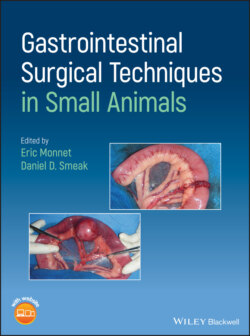Читать книгу Gastrointestinal Surgical Techniques in Small Animals - Группа авторов - Страница 96
5.2.2 Surgical Placement of a Closed Suction Drain
ОглавлениеAccording to the dynamic of fluids in the abdominal cavity, abdominal effusion moves from the caudal to cranial toward the diaphragm (Hosgood et al. 1989). Therefore drains need to be placed in the cranial part of the abdominal cavity between the liver lobes and the diaphragm. In this position the drain should be more efficient for collecting in the abdominal cavity and also it should keep the drain away from the omentum.
A Jackson–Pratt system, commonly made with a flat silicon drain, is placed in the abdominal cavity as described above (Figure 5.2). The flat silicon drain comes in different diameters. The tube is tunneled throughout the abdominal wall and the skin with a sharp trocar. A trocar is used to create a tight seal of the abdominal wall, subcutaneous tissue, and skin around the tube. Usually the exit point is in the left or right caudal abdomen.
Figure 5.2
Figure 5.3
A Chinese finger trap is used to secure the drain to the skin. The drain and the reservoir have to be well protected to prevent accidental removal of the drain by the patient. A suction device with a reservoir is connected to the drain (Figure 5.3). The device generates a negative pressure close to 10 mmHg. Usually the reservoir can be 100–400 ml, depending on the size of the animal and the amount of effusion that is expected to be produced. The reservoir has to be emptied as needed to maintain constant negative pressure in the abdominal cavity.
The drain needs to be inspected daily to reduce the risk of contamination and ascending infection.
